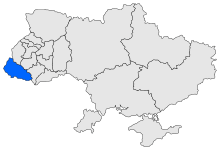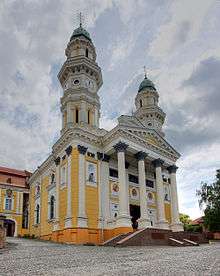Greek Catholic Eparchy of Mukachevo
The Greek Catholic Eparchy of Mukachevo[1] is an eparchy (diocese) associated with the Ruthenian Greek Catholic Church under an unidentified status[2] and territory located in the west of Ukraine, roughly equivalent with Zakarpatska Oblast. The eparchy was created by the Pope Clement XIV in 1771.
Greek Catholic Eparchy of Mukacheve Eparchia Munkacsiensis | |
|---|---|
 | |
| Location | |
| Country | Ukraine |
| Statistics | |
| Population - Total | (as of 2010) 380,000 |
| Parishes | 402 |
| Information | |
| Denomination | Catholic Church (Eastern Catholic) |
| Rite | Byzantine Rite |
| Established | September 19, 1771 |
| Cathedral | Holy Cross Cathedral |
| Patron | Theodore Romzha |
| Secular priests | 261 |
| Current leadership | |
| Pope | Francis |
| Bishop | Vacant |
| Apostolic Administrator | Nil Lushchak |
| Map | |
 | |
| Website | |
| www.mgce.uz.ua | |
The eparchy is in full communion with the Catholic Church. Its parishes observe the Byzantine Rite which is also celebrated by the majority of Orthodox Christians, and as provided for in the original terms of the Union of Uzhhorod.
The eparchy is a mother eparchy of at least three modern metropoles, i.e., the Slovak Greek Catholic Church, the Romanian Greek Catholic Church, and the Hungarian Greek Catholic Church, as well as the Byzantine Catholic Archeparchy of Pittsburgh in the United States.[3]
History
Some historians believe that the origins of the eparchy are to be found in the missionary work of Saints Cyril and Methodius in the ninth century. The 14th century saw the founding of the famous Saint Nicholas Monastery on "Chernecha Hora" or "Hill of Monks" located in the city of Mukacheve. Many believe that from that point, the Eparchy of Mukacheve evolved into the entity as we know it today. The bishops resided at the Monastery and administered ecclesiastical affairs from there until 1766. After the union with Rome and until 1946, the Monastery of St Nicholas was also the principal religious house of the monks of the Order of Saint Basil the Great (OSBM), also called Basilian monks.[4]
The bishops, clergy and faithful of this eparchy were originally Orthodox Christians at some point were reconstituted under an eparchy suffragan to the original Metropolitan of Kiev (Rhosia Orthodox Church) that was under the jurisdiction of the Patriarch of Constantinople (see Eparchy of Mukačevo and Prešov).
In 1646, following the example of their compatriots across the Carpathian Mountains in Galicia (current day Western Ukraine), who in 1596 established the Union of Brest, the people of the Mukacheve eparchy united with the papal Holy See (recognizing the primacy of Catholic Rome, not Byzantine, Orthodox 'second Rome' Constantinople) under what is known as the Union of Uzhhorod. Other Eastern Orthodox Christians who belonged to the original Eastern Orthodox eparchy of Mukacheve and refused to convert joined the eparchy of Buda that is suffragan to the Serbian Patriarchate of Peć (and later Patriarchate of Karlovci).
In the political and spiritual climate of the day, union with Rome was considered by many to be a productive solution to promoting both the welfare of the people and the church. Following a model similar to that proposed at the Council of Florence, the people were allowed to maintain their Byzantine Rite spiritual, liturgical and canonical traditions, while recognizing the Roman Pontiff as the head of the universal church.[4] From 1646 to 1771 the eparchy was suffragan to the Roman Catholic Archdiocese of Eger.
On September 19, 1771, after decades of efforts on the part of the bishops of Mukacheve for recognition as a fully self-governing ecclesiastical entity, free from the control of the Latin Catholic bishops of Eger (today in Hungary), the Habsburg Holy Roman Empress Maria Theresa issued a decree, subsequently approved by Rome, that created a jurisdictionally independent Mukacheve Eparchy no longer subordinate to the Latin Rite ordinary. It was also at this time that the faithful of the eparchy formally became known as Greek Catholics. During the episcopate of Bishop Andrii Bachynskyij (1772-1809), the eparchy retained its historic name but its seat was moved to Uzhhorod (1780), where it remains to this day. The Cathedral of the Exaltation of the Holy Cross in Uzhhorod is the seat of the eparchy.[4]
Following the Second World War and the occupation of Carpatho-Ukraine by the Soviet regime, the Greek Catholic Church was liquidated in 1949. All properties were allocated to the Russian Orthodox Church and the clergy and many faithful exiled to concentration camps. The bishop of Mukacheve during this time was Theodore Romzha. In 1947, Bishop Romzha was poisoned by NKVD (predecessor of the KGB) authorities. During the Soviet years, the Greek Catholic Church in Galicia, Transcarpathia and Slovakia continued to operate secretly in the underground.
With the collapse of the Soviet Union, many priests and faithful of the Eparchy of Mukacheve came out of the catacombs. The eparchy was allowed to officially renew its activities in 1989. Bishop Ivan Semedi, who had been secretly consecrated during the persecution years, was the first bishop to freely perform his ministry in over 40 years.
Bishops

The list of the eparchs (bishops) of the Greek Catholic Eparchy of Mukacheve is:[5][6][7]
Eastern Orthodox bishops
- Hierotheos, 940
- Joannes I, 1491-1498
- Basilius I, 1551-1552
- Hilarius I, 1556-1559
- Euthymius I, 1561-1567
- Amphilochius, 1569-1596
- Basilius II, 1597-inc.
- Sergius, 1601-1616
- Sophronius I, 1616
- Hilarius II
- Euthymius II, 1618-inc.
- Petronius, 1623-1627
- Joannes II (Gregorowicz), 1627-1633
- Basilius III (Tarasowicz), 1634-1642
- Porphyry (Arden), 1640—1643
- Sophronius II (Yusko), 1646 (Vlach)
- Basilius III (Tarasowicz), 1646-1648
- Parfeniy (Petrovych-Ratoszynski), 1648—1649
- Joannicius (Zeikan), 1652—1686
- Theophanes (Mavrokordato), 1677 (Archbishop of Hungarian Ruthenia)
- Methodius (Rakovecki), 1687—1692
- Joseph (Stojka), 1692—1711
- Dosyteus (Feodorowicz), 1711—1734
Greek Catholic bishops
- after the 1646 Union of Uzhhorod the Eparchy of Mukacheve united with Rome
- Vasyl Tarasovych, 1646-1648
- Petro Parfenii, 1649-1665
- Yosyf Voloshynovskyi, 1670-1673
- Porphyriy Kulchynskyi, 1681-1686
- Yosyf de Kamelis (Joseph de Camillis), 1690-1706
- Yosyf Hodermarskyi, 1706-1716
- Hennadiy Bizantsiy, 1716-1733
- Stefan Olshavskyi, 1733-1737
- Havryil Blazhovskyi, 1738–1742
- Manuil Olshavskyi, 1743–1767
- Ivan Bradach, 1767–1771
- In 1771 the Eparchy of Mukacheve got his independence from the Latin bishop of Eger
- Ivan Bradach, 1771–1772
- Andriy Bachynskyi, 1773–1809
- auxiliary bishop Mykhaylo Bradach, 1808–1812
- Mykhaylo Bradach, Apostolic Administrator, 1812–1815
- Oleksiy Povchiy, 1816–1831
- Vasyl Popovych, 1837–1864
- Stefan Pankovych, 1866–1874
- Ivan Pasteliy, 1876–1891
- Yuliy Firtsak, 1891–1912
- coadjutor bishop Antal Papp, 1912
- Antal Papp, 1912–1924
- Petro Gebey, 1924–1931
- Oleksandr Stoyka, 1932–1943
- Miklós Dudás, Apostolic Administrator, 1943–1946
- Bl. Teodor Romzha, 1944–1947
- In 1949 the Communist Ukrainian Soviet Socialist Republic abolished the Greek Catholic Church; all its properties were allocated to the Russian Orthodox Church.
- Clandestine Bishops
- Alexander Chira, 1944–1983
- Petro Oros, 1944–1953
- Konstantyn Sabov, 1977–1982
- Ivan Semedi, 1978–1991
- Yosyf Holovach, 1983–1991
- Ivan Margitych, 1987–1991
- In 16 January 1991 the Holy See confirmed all clandestine consecrations
- Ivan Semedi, 1991-2002
- auxiliary bishop Yosyf Holovach, 1991–2000
- auxiliary bishop Ivan Margitych, 1991–2002
- auxiliary bishop Đura Džudžar, 2001–2003
- Milan Šašik, Apostolic Administrator, 2002–2010
- Milan Šašik, 2010–2020
- auxiliary bishop Nil Lushchak, 2012–2020
- Nil Lushchak, Apostolic Administrator, since 2020
Statistics
In 2014 the eparchy had 320,000 faithful, 2 bishops, 429 parishes, 280 diocesan priests, 30 religious priests, 44 men religious, 45 women religious, 0 deacons and 98 seminarians.[8]
See also
Sources & External Links
References
- Greek Catholic Eparchy of Mukachevo. Official site.
- Greek Catholic Eparchy of Mukachevo Archived 2012-12-12 at the Wayback Machine. World Academy of Carpatho-Rusyn Culture.
- Havrosh, O. Bishop Milan: "Eparchy of Mukachevo belongs to the biggest in Ukraine" (Владика Мілан: «Мукачівська єпархія належить до найбільших в Україні»). Eparchy of Mukachevo website from Mirror Weekly. 6 July 2012
- "Archived copy". Archived from the original on 2012-12-12. Retrieved 2010-09-10.CS1 maint: archived copy as title (link)
- Eparchy of Mukacevo (1893). Schematismus Cleri Graeci Ritus Catholicorum Dioecesis Munkácsensis. p. VI.
- Pelesz, Julian (1881). Geschichte der Union der ruthenischen Kirche mit Rom. Woerl. p. 1088.
- "Eparchy of Mukachevo (Munkács) (Ruthenian)". Catholic-Hierarchy.org. David M. Cheney. Retrieved 23 January 2015.
- Ronald Roberson (source: Annuario Pontificio 2014) (January 10, 2015). "The Eastern Catholic Churches 2014" (PDF). Catholic Near East Welfare Association.
Further reading
- Pekar, Athanasius B. (1979). The Bishops of the Eparchy of Mukachevo, with Historical Outlines. Pittsburgh: Byzantine Seminary Pres.CS1 maint: ref=harv (link)
- Véghseő, Tamás (2015). "Reflections on the Background to the Union of Uzhhorod / Ungvár (1646)" (PDF). Eastern Theological Journal. 1 (1): 147–181.CS1 maint: ref=harv (link)

